Corel Painter 2022, Hands On: Enhanced Usability Takes Centre Stage
Most software releases have at least one big new feature. After years of quietly improving the back end of Painter (and there are more performance improvements here), with this release Corel has focused instead on how artists actually use the program, delivering basic-sounding updates that combine to make working with Painter 2022 far easier, less frustrating and more fun.
That's possibly more useful than yet more features, since Painter already has a lot of features. Increasingly, the problem was finding them and understanding which ones would work well together. For example, Painter has multiple brush engines (the code that handles the shape of the brush, the type of paint on the brush and how that paint interacts with the canvas); many of them you can use together, but some have been reserved for specific types of layers. The richness and versatility of those different brush engines also made it complicated to customise a brush for the way you want to paint, or even find the right brush in the first place.
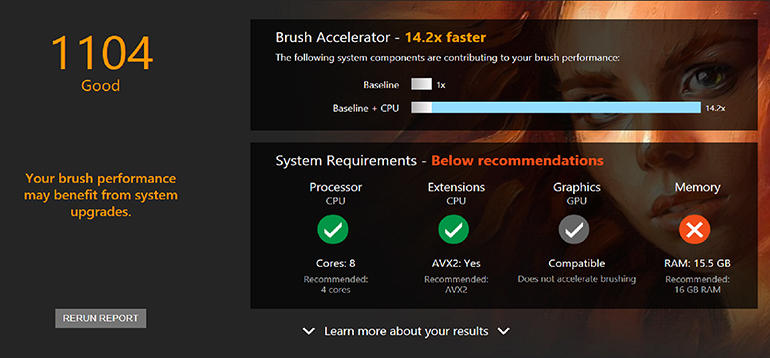
Painter 2022 shows whether your hardware accelerates different tools.
Image: Mary Branscombe / ZDNetEvery release of Painter added new brushes, and highlighted them as a new collection in the brush library. That was good for spotting new tools to try out, but many years of new brushes it made it difficult to find the ones you wanted without building your own set of custom brush palettes. It was also overwhelming for beginners.
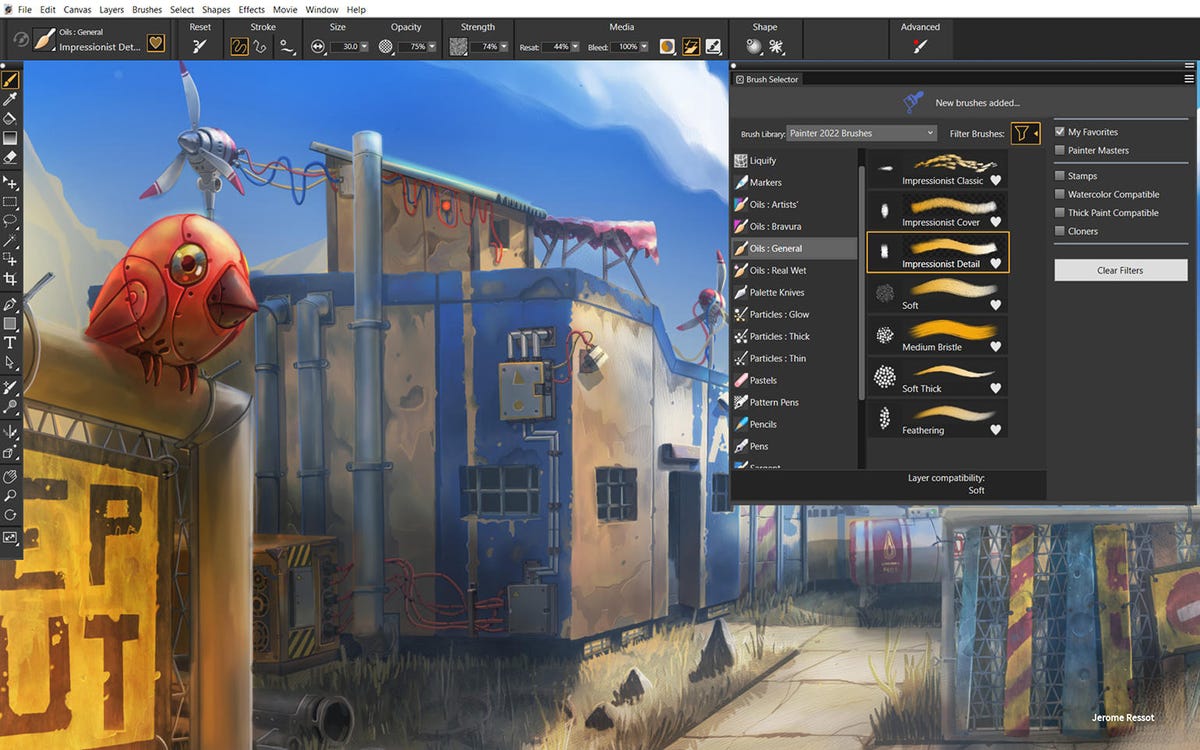
The new brush library is far better organised and easier to work with.
Image: CorelNow the brush library is arranged into 35 categories. Some are obvious like separating chalk and pastels into groups like acrylics, gouache or pencils, while large categories like cloning, oils, particles, thick paint and watercolour are split into logical groups (the watercolour 'fringe' brushes are what used to be labelled 'digital' watercolour). And you can finally mark the brushes (or entire groups of brushes) you use the most as favourites and filter to show just those brushes. You can also filter to just stamp, cloning, watercolour or thick paint brushes, or see expert-recommended brushes.
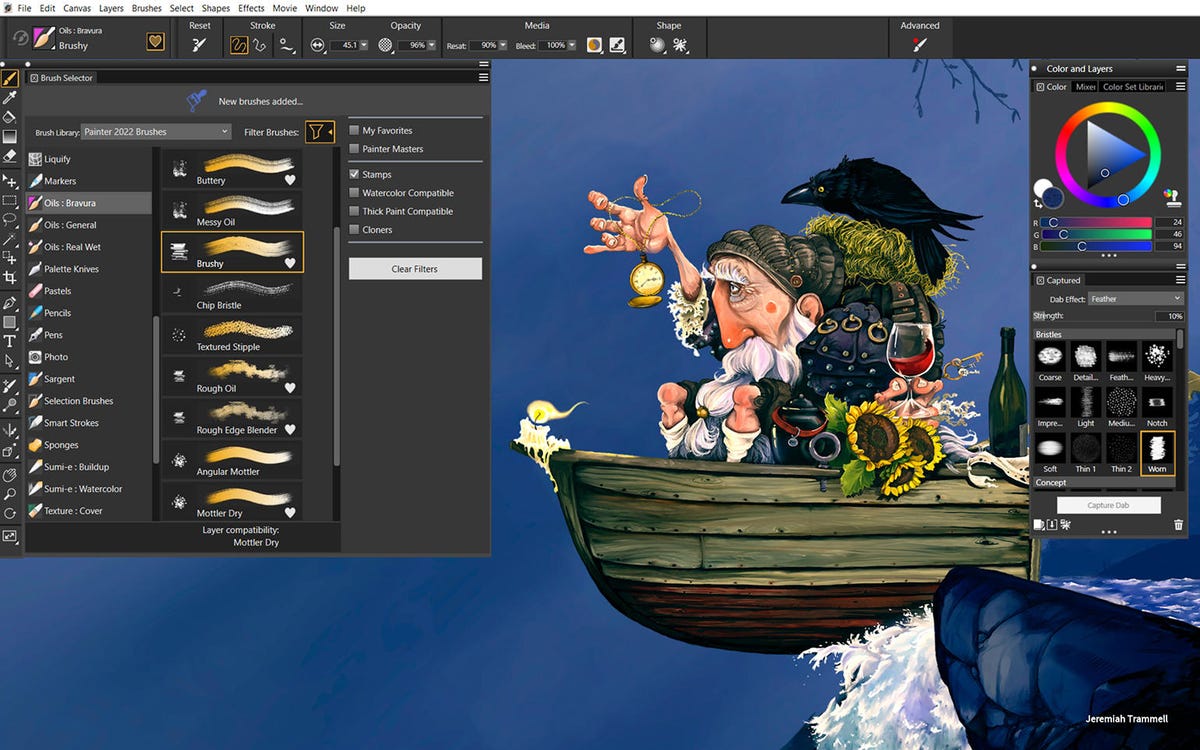
You can finally mark the brushes you use frequently as favourites and filter for brushes that work on specific media types.
Image: CorelThis might sound basic, but it absolutely transforms the experience of working with Painter, whether you're a new user or and expert, and Corel is to be congratulated on focusing -- albeit belatedly -- on making the software so much easier to use.
There's also a new brush size panel that you can keep visible so that you don't have to go back to the property bar to change sizes as you move from between general painting and detail work -- you can just pick a different brush size. That makes it quick to get the precision to change, say, the colour of a character's eyes right at the end of the process; in older versions of Painter it was tempting to drop out to another tool to make those little changes.
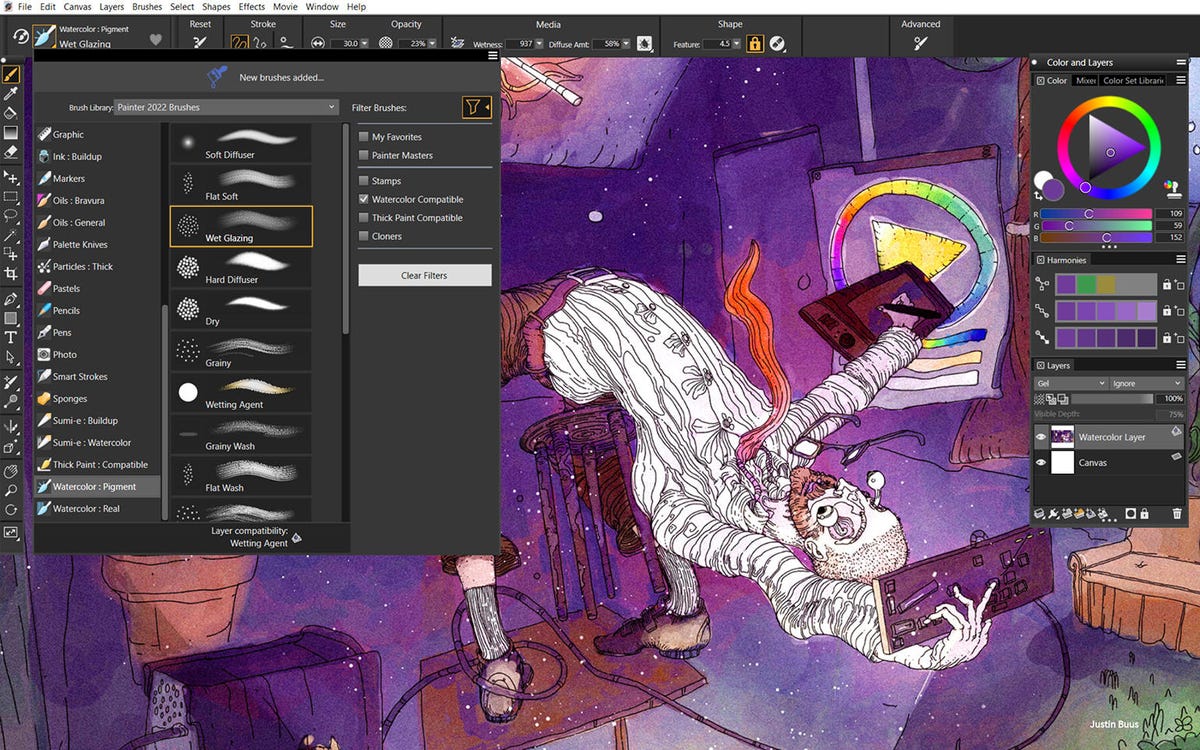
Working with watercolours is now much more flexible, and you can combine them with brushes like chalks.
Image: CorelWatercolours were a powerful but also complicated option in Painter. Corel tells us that around a third of artists use watercolour features for anything from creating a background wash to paint over to creating entire illustrations, but until now they had to be on their own layer -- and you had to hunt for which brushes would actually work on a watercolour layer. Much as Painter 2021 made thick paints easier to use alongside other tools, Painter 2022 makes the watercolour tools much more flexible. The brush library filter solves the problem of finding brushes that work, and you can use many more brushes like chalk and charcoal on a watercolour layer to get the effect you want. These interact the way you'd expect them to in the physical world: draw in chalk and then paint with a watercolour tool like the bristly brush, and when you stop, the paint will drip and blend with the chalk that's already on the watercolour layer. You can also perform transformation on watercolour layers -- skewing, distorting, rotating, scaling or adjusting for perspective -- without having to change them into default layers that don't support watercolour painting.
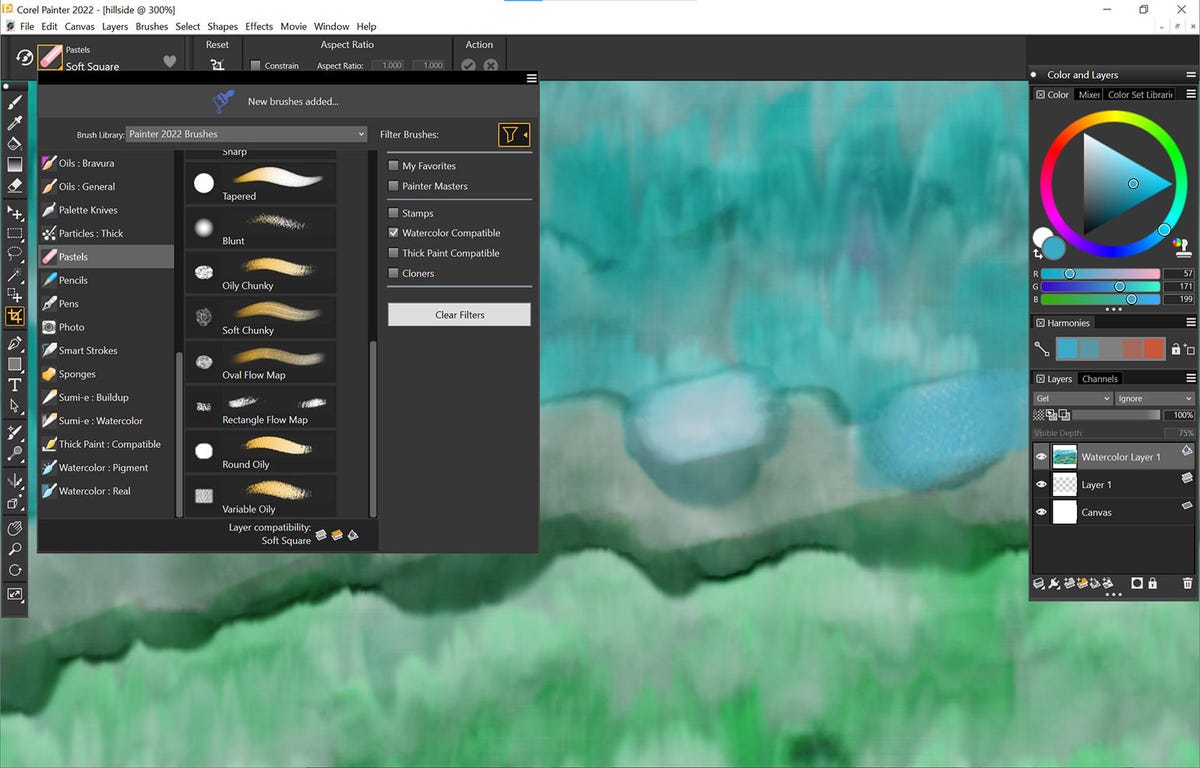
Painting with watercolours looks more realistic, as well as being more fun when you can find the right brushes.
Image: CorelIf you're painting the label for a package, you might want to apply perspective to see how it will look on the box and keep on painting with that perspective to see how it looks. Previously you would have had to save a copy or make a duplicate, apply the perspective and go back to the original to do more work.
Any brush that puts an image on the canvas -- which is how painting brushes actually work -- is technically a stamp brush -- you're 'stamping' an image of the dab the brush makes on the canvas (it doesn't have to be an obvious image that looks like a sticker stuck on the artwork). There are new stamp brushes in many categories that look more realistic, and you can now customise any stamp brush by editing the dab and adding effects to it; for example, you can make the edges of the brush stroke smoother or feather them, choose the opacity or rotate and squeeze the bristles. You can draw with a brush you've adjusted and save that as a dab, or import a JPEG or PNG as a custom brush: if you need to touch up an artwork you worked on some time ago, you can make a brush for specific elements like leaves or flowers and quickly draw more of them in the required colour palette.
This gives you as much control and precision as you want to get exactly the brush stroke that's right for the details of what you're painting, and it's very easy to work with. Some of these tweaks you couldn't do at all before, and when you could it took a lot of time and effort. Now you can quickly build up a library of custom brushes that work exactly the way you want them to, which unlocks more creativity than spending time just grouping the built-in brushes so you can find them.
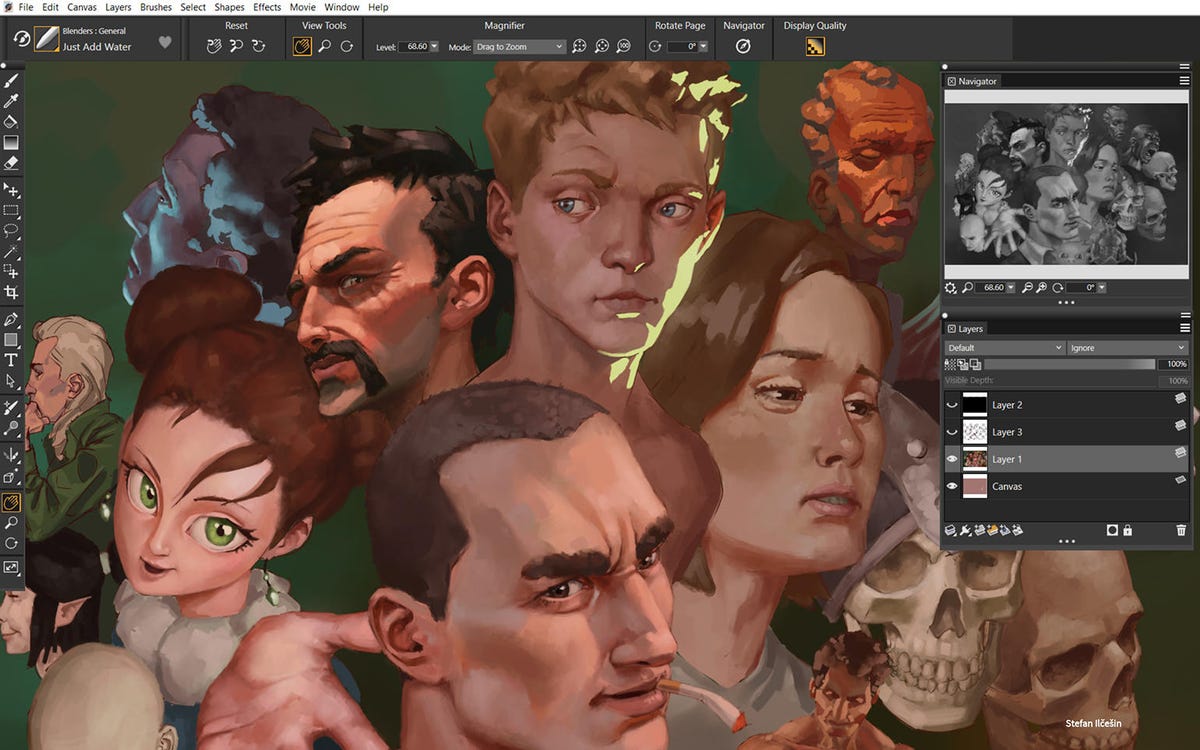
Painter 2022's grayscale preview helps artists check the dynamic range of their image to see if they have the emphasis they want
Image: CorelLayers are also much easier to work with (and will be more familiar to designers used to industry-standard applications like Photoshop). You can move layers up and down by dragging them, focus on just one layer and turn off all the others (Corel calls this 'spotlight'), shift-click to select and lock multiple layers (even if they're not next to each other in the layer palette) or hide and unhide groups of layers. You can burn or dodge layers as you combine them to add lightness or darkness. If you want to get rid of all the content on a layer there's a new delete button that replaces the need to select or undo individual areas, and when you're happy with several layers you can drop them all onto the canvas in one go. You can also see a greyscale preview of your artwork from the layer navigator, allowing you to check the tonal range quickly without being distracted by the colours -- this is the painting equivalent of photography shortcuts like the rule of thirds, and it's nice to see it made so easy.
Painter is a high-end creative application that benefits from powerful hardware (it needs a very recent version of Windows 10 too). It hasn't always been easy to take advantage of that power, and Painter 2022 offers a much better balance between realistic digital paint and the experience of painting that feels like just picking up a brush and being creative.
Pricing
$429 USD / €424.95 / £359.99 (full package); $229 USD / €218.95 / £179.99 (upgrade)
$199 / €225 / £159 (annual subscription)
RECENT AND RELATED CONTENT
Corel Painter 2021, hands on: Performance and productivity improvements, plus a subscription model
Corel Painter 2020, hands on: Performance and interface tweaks enhance user experience
CorelDRAW Graphics Suite 2021 review: Improved collaboration tools and streamlined workflows
CorelDRAW Graphics Suite 2020 review: Faster, with more AI and added collaboration
CorelDRAW Technical Suite 2020: A complete set of tools for technical illustrators
Read more reviews
- Raspberry Pi Compute Module 4 review: A building block for new devices
- ZTE Axon 30 Ultra 5G review: Affordable flagship with advanced triple camera shooting modes
- Apple MacOS Monterey: Hands on with the public beta
- Huawei Mate X2, OnePlus Nord CE 5G, Dell XPS 13 9310, and more: ZDNet's reviews roundup
- Google Pixel Buds A-Series review: Affordable, secure, and optimized for Android
Reassessing AI Investments: What The Correction In US Megacap Tech Stocks Signals
The recent correction in US megacap tech stocks, including giants like Nvidia, Tesla, Meta, and Alphabet, has sent rippl... Read more
AI Hype Meets Reality: Assessing The Impact Of Stock Declines On Future Tech Investments
Recent declines in the stock prices of major tech companies such as Nvidia, Tesla, Meta, and Alphabet have highlighted a... Read more
Technology Sector Fuels U.S. Economic Growth In Q2
The technology sector played a pivotal role in accelerating America's economic growth in the second quarter of 2024.The ... Read more
Tech Start-Ups Advised To Guard Against Foreign Investment Risks
The US National Counterintelligence and Security Center (NCSC) has advised American tech start-ups to be wary of foreign... Read more
Global IT Outage Threatens To Cost Insurers Billions
Largest disruption since 2017’s NotPetya malware attack highlights vulnerabilities.A recent global IT outage has cause... Read more
Global IT Outage Disrupts Airlines, Financial Services, And Media Groups
On Friday morning, a major IT outage caused widespread disruption across various sectors, including airlines, financial ... Read more

